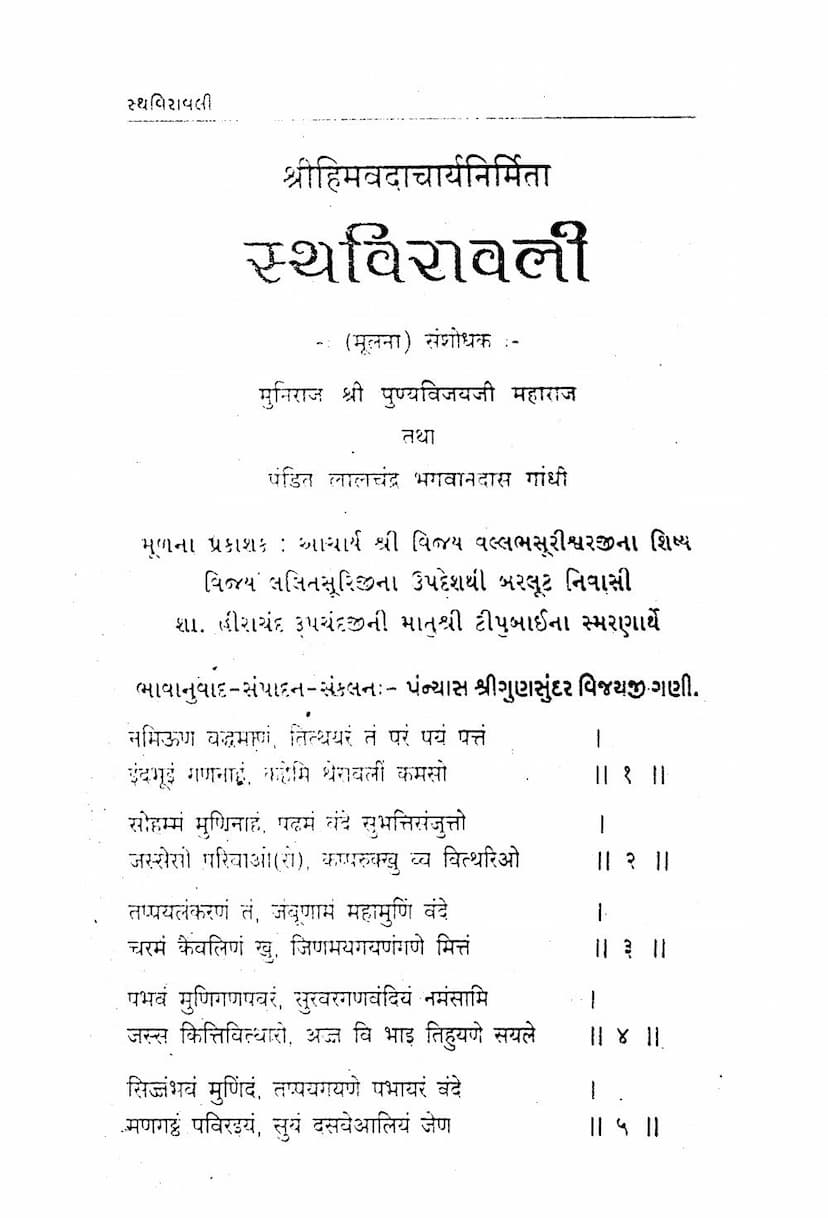Sthaviravali
Added to library: September 2, 2025

Summary
Here's a comprehensive summary of the Jain text "Sthaviravali" based on the provided pages:
The Sthaviravali (Book of Elders) is a significant Jain text compiled by Himavadaacharya. The presented text is a revised edition, with contributions from Muniraj Shri Punyavijayji Maharaj and Pandit Lalchand Bhagwandas Gandhi, and originally published under the guidance of Acharya Shri Vijay Vallabhsurishwarji.
The work aims to chronicle the lineage of important Jain monks (Sthaviras) and their significant contributions, primarily focusing on the transmission of Jain teachings and scriptures. The text starts with invocations and salutations to prominent spiritual figures.
Key themes and content covered in the Sthaviravali include:
- Genealogy of Sthaviras: The text meticulously traces the succession of eminent monks, highlighting their gurus and disciples. It mentions figures like Indrabhuti Gautam (the first Gandhara of Mahavir), Agniśākhagupta, Ajāmbu, Pabhavaswami, Sambhūta, Jayasabhūti, Sthulabhadra, and Ajita.
- Transmission of Scriptures (Pūrvas & Angas): A central theme is the preservation and transmission of the Jain scriptures, particularly the Śrutakevalins (those who possess all knowledge) and the Pūrvadharas (holders of the fourteen Purvas). The text emphasizes the efforts of Sthaviras in keeping these ancient texts alive, especially during times of famine or disruption.
- The Role of Sthulabhadra: Sthulabhadra is highlighted as a significant figure, known for his influence and prowess in the Magadha region. The text mentions his ability to control elephants, symbolizing his command over powerful forces.
- The Concept of Jinakalpa and Sthirakalpa: The text touches upon different monastic traditions within Jainism. The Jinakalpa seems to represent a stricter, more austere path, while the Sthirakalpa might refer to a more established or settled tradition. Figures like Ajita Mahagiri and Ajita Suhasthi are associated with these traditions.
- Historical and Royal Patronage: The Sthaviravali intertwines the spiritual lineage with the historical context of ancient Indian kingdoms. It frequently mentions the patronage of Jainism by prominent kings, particularly in Rajagriha, Pataliputra, and the Kalinga region.
- King Shrenika (Bimbisara): A devoted follower of Lord Mahavir, who built significant Jain temples and caves.
- Ajatashatru: Shrenika's son, who also followed Jainism.
- Udayin: Son of Ajatashatru, who established Pataliputra.
- Chandragupta Maurya: His rise to power and subsequent devotion to Jainism are mentioned, along with the establishment of the Mauryan era.
- Ashoka: The text describes his conversion to Buddhism (though he initially followed Jainism) and his propagation of Buddhist teachings across different regions. It also mentions his son Kunala and grandson Sampati.
- Sampati: His past life as a poor man named Damaga who became a Jain monk is narrated, highlighting the transmigration of souls and the impact of karma. His efforts in spreading Jainism are also detailed.
- Vikramarka: A significant king associated with the Avanti region, known for his valor, generosity, and devotion to Jainism.
- The Compilation of the Eleven Angas: A crucial event described is the arduous task undertaken by Arya Skandila and Arya Gandhahasti to recompile the eleven Angas of the Jain canon. This was done during a severe famine when many scriptures were lost. They gathered monks, compared their remaining texts, and reconstructed the Angas, making Jainism known in the "Mathuri Vachan" (Mathura dialect).
- The Role of Lay Patrons: The text acknowledges the significant contribution of lay followers (Shravakas and Shravikas) who supported the monastic community and helped in the propagation of Jainism through donations and patronage.
- The Importance of Dharma and Karma: Throughout the narrative, the principles of karma and the importance of following Jain Dharma for spiritual upliftment and liberation are consistently emphasized. The actions of kings and monks are often described in relation to their karmic consequences.
- The Preservation of Jain Tradition: The Sthaviravali serves as a testament to the resilience of the Jain tradition, highlighting the continuous efforts of scholars and ascetics to preserve its teachings and practices through various historical periods.
In essence, the Sthaviravali is a historical and spiritual chronicle that illuminates the lineage of Jain elders, their dedication to preserving scriptures, their interactions with royal patrons, and their role in the propagation and sustenance of Jain dharma throughout ancient India.